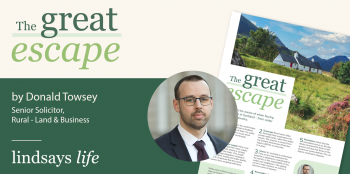As the Scottish and UK governments plan for COP26 in Glasgow and, beyond that, for a sustainable green recovery, the subjects of natural capital and environmental business planning have moved up the agenda.
With investors wary of businesses with negative environmental impacts and legislators looking at climate change-related regulation in all sectors, it pays to be proactive about targeting carbon-neutralising solutions and biodiversity net gains. It is also likely that both policymakers and markets will increasingly reward rural businesses that deliver public good in their management of natural capital.
New approaches to land management
As people adapt to this new world, woodland creation and management is an area of growing interest to many. This is not least because, given the long existence of grants and tax breaks for forestry, it does not require too much of a mental leap. Secondly, previously less-favoured hillside or other unproductive rural land is increasingly attractive for companies and institutional investors looking to offset their carbon footprint. But land owners and managers would be wise not to focus on this exclusively at the expense of other options.
One such option is wildlife management. With funders and investors likely to monitor biodiversity as well as carbon sequestration, there are compelling reasons to look at woodland and wildlife management (as well as sporting and other land use) holistically.
Targeting biodiversity gains
The benefits of woodland creation and management go far beyond tax breaks, grants and revenues from timber sales, and carbon offsetting. Planting trees can also deliver biodiversity net gains, with case studies across Scotland showing that responsible forestry can positively impact the survival of different species.
The best-known examples of this focus on iconic Scottish species such as wildcats and capercaillies but the opportunities for conservation and biodiversity also include birds, amphibians, butterflies and insects. The pine hoverfly may not previously have appeared high on your radar, but Scottish ministers consider it highly important to biodiversity conservation.
Navigating the terrain
As individuals, businesses and governments look to navigate the recent challenges of the Covid-19 crisis, woodland and wildlife management are areas of strong economic potential for rural businesses. The pandemic appears not to have negatively impacted land values, and there is a heady combination of tax, cash and environmental incentives in play – fuelled in part by the Scottish Government’s target of planting 36 million trees by 2030.
A few words of caution apply, however. Turning wildlife management and biodiversity into a revenue stream is more complex than simply breeding pine hoverflies on conifer stumps. It’s a complex and often contested area. A delicate balance must be achieved between different economic, social and environmental perspectives. The Shared Approach to Wildlife Management concordat, adopted by Scottish Land & Estates, National Farmers Union Scotland, NatureScot, RSPB and the British Association for Shooting and Conservation among many others, provides a useful reference point.
Woodland management can also be difficult terrain to navigate, given the often complex environmental, financial, legal and land use issues involved. But voluntary standards such as the Woodland Carbon Code can help projects demonstrate how much carbon they sequester, offering confidence and legitimacy to businesses. There are also reporting tools available to help landowners and managers measure and report on the improvements they make to their land.






